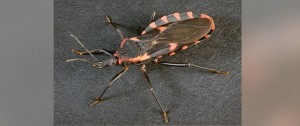“Kissing Bugs” and Chagas Disease in Dogs

Symptoms of Chagas In Dogs
There are two forms of Chagas disease in dogs: acute and chronic. One of the main problems with detection and treatment is a long asymptomatic period (where no symptoms develop), which can last years in some cases. There is a progressive multiplication of the parasite, eventually leading to the degeneration and inflammation of the heart. This heart issue can eventually cause heart failure and death.
Acute Chagas (dogs younger than 2 most typically)
Diarrhea
Depression
Lethargy
Exercise intolerance
Difficulty walking
Seizures
Lymph nodes swelling
Increased heart rate
Congestive heart failure
Chronic Chagas (older dogs typically)
Weakness
Fainting
Exercise intolerance
Increased heart rate
Causes
Chagas may occur when an insect, such as a kissing bug (Triatominae), bites the dog on the skin or lips and leaves infected feces in the wound. It can also occur when a dog eats feces from an infected animal like an opossum, raccoon, and armadillo.
Diagnosis
If you notice symptoms of any kind, immediately visit a veterinarian and ask for an examination, as well as an order of a blood chemical profile, a complete blood count, a urinalysis, serology and an electrolyte panel — essentially the typical procedure for a suspected parasitic infections.
X-Rays can potentially show Chagas issues, and an echocardiogram may show chamber or wall abnormalities. These types of abnormalities are often seen in sudden or chronic forms of the disease.
Treatment
Typically, supportive treatment of heart complications (e.g., heart arrythmias) is the main way to treat Chagas, as there is no known cure. Although several drugs have shown some promise, there is no valid associated treatment that reverses the symptoms.
Living and Management
Unfortunately the veterinarian may suggest euthanization as a means of preventing suffering due to the grave prognosis associated with chronic Chagas. Dogs diagnosed with acute Chagas are generally listed as “guarded” meaning that there is a poor prognosis and a general expectation of failure over time.
